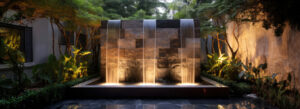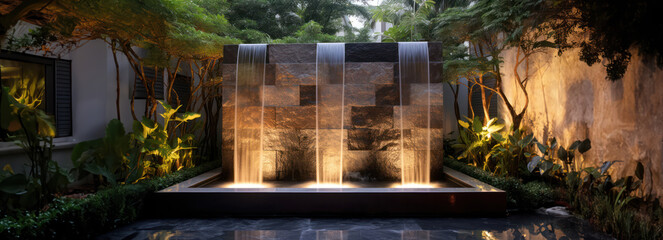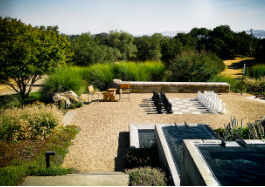Landscape Lighting Miami is a high-demand upgrade that will make your home more appealing to potential buyers. It can also provide safety and security benefits.
Up-lighting (also known as silhouette lighting) is a technique used to highlight an object by casting a dark shape against the wall behind it. Use spotlights with a wider beam angle to create the effect.

Many homeowners put a lot of work into their gardens, lawn care, and porch decorations. However, these elements often go unnoticed at night. Professionally installed landscape lighting can highlight your home’s unique features to create a warm and welcoming atmosphere after dark. It can also improve safety and security by illuminating the path from your driveway to the front door.
Curb appeal is important to any homeowner, and the right lighting design can take it to a whole new level. The right placement and use of fixtures will illuminate areas where you want to draw attention, like a front door or garden sculpture. It can also highlight architectural features such as a gable, symmetrical pillars or stone facade to give your home a gorgeous look that will stand out at night.
A well-lit walkway can also deter burglars and keep family members and guests safe from tripping or falling over obstacles after dark. Landscape lights can also add to the ambiance of a deck, patio or backyard party. The wide range of color options can set a festive mood or evoke an enigmatic, mysterious feel.
Landscape lighting can also show off hardscape and softscape features of your yard. By highlighting these features with illumination, you can increase the value of your property while creating a warm and inviting space for family and friends. There are many different techniques that can be used to light up a yard or landscape feature, including up-lighting (highlighting the structure with shadow and light), down-lighting (creating a soft, moonlit effect) and cross-lighting (highlighting both sides of a non-uniform shape).
Curb appeal is an important factor when it comes to home sales, and landscape lighting can help you boost your home’s value by showing off its beautiful features after dark. It can also add a sense of safety and security to your home, which can be appealing to potential buyers looking for a safe place to live. For more information about the benefits of landscape lighting, contact us today! We would be happy to answer any questions and provide you with a free estimate.
When most people think of landscape lighting, images of beautifully illuminated trees and accentuated architectural features come to mind. But the best landscape lighting isn’t just for beauty; it also helps to keep family members, guests and even delivery drivers safe on a property after dark.
One of the biggest safety benefits of landscape lighting is that it helps to eliminate tripping hazards in walkways and other outdoor spaces after dusk. This is a big safety benefit because falls are a common cause of injury at home. With well-placed landscape lighting, potential tripping hazards can be illuminated before they become an issue, making your home a safer place for everyone to enjoy.
Another safety benefit of landscape lighting is that it can help to deter crime. This is primarily because lighting can make it more difficult for criminals to hide or move around a property, so they are more likely to be seen by someone passing by. This is especially helpful if the lighting is strategically placed to light up dark corners, which can be a hiding spot for prowlers.
To improve the security of your property, you should opt for lighting that is a combination of tasteful floodlights from below and attractive lighting from above. This will allow you to adequately illuminate the entry of your home, ensuring that any potential intruders are clearly visible. You should also try to avoid using halogen bulbs, which are a common choice for landscape lighting because they use more energy than LEDs and don’t last as long.
There are many options for lighting fixtures, from high-end, decorative fixtures that look like lanterns or sconces to low-cost LED fixtures. You can choose lights that are integrated, meaning that they have the LED board built into them and only require a bulb to operate. This saves on installation costs, but it can be more difficult to replace a burned-out fixture. Other options include lamp-ready fixtures, which simply take a standard Edison-style bulb. This gives you more flexibility in terms of brightness (lumens), color temperature, and beam spread.
A well-lit outdoor space is an inviting place for guests after dark and accentuates the beauty of trees and other landscape features. Lighting techniques, like silhouetting, grazing, or cross-lighting, reveal texture and definition to really make these elements stand out.
When properly maintained, a well-designed landscape lighting scheme can last for years without burning out bulbs or overheating fixtures. However, maintaining your lighting requires more than simply ensuring the proper positioning and distance of each fixture. You must also keep your yard free of leaves and other debris that can cause overheating. It’s also a good idea to regularly check each fixture to ensure it is working correctly and has not burned out.
Landscape lighting not only provides safety and security, but also helps extend the usability of your outdoor spaces. This makes it a great way to maximize your home’s value and provide a pleasant experience for guests after dark. In addition, you can choose to highlight a specific feature or ambiance with the use of different colors and lighting techniques.
The popularity of landscape lighting continues to grow and homeowners continue to look for ways to improve their outdoor spaces with a high-return investment. With the help of experienced contractors, the right landscape lighting installation can create a dramatic effect and perfectly balance function and aesthetics to transform your property.
Aside from increasing the safety and beauty of your outdoor spaces, a quality lighting scheme can be energy-efficient, especially when it uses LED lights. Unlike traditional incandescent bulbs, these lights are more efficient and do not generate heat, which can damage some plants and structures.
There are many benefits of installing landscape lighting on your property. It not only enhances the curb appeal of your home, but it also helps increase the functionality of your outdoor space after dark and sets a mood. In addition, it can be a cost-effective and stress-free upgrade. The most important thing to remember when planning your landscape lighting is to find a style that best suits you and your property. With the many options available today, there is sure to be a solution that fits your needs and budget.
Low-voltage lighting systems require very little upkeep to maintain their beauty and functionality. A typical system is simple enough that homeowners can handle the installation themselves with the help of a few tools and a basic understanding of electricity. All you need is a transformer, low-voltage electrical cable, and the lights themselves. It’s not necessary to be comfortable with wiring or even have done any electrical work before tackling this project.
While low-voltage landscape lighting is easy to install, it’s important that the layout be carefully planned out before beginning the project. Start by walking the property and drawing a rough sketch of where you’ll be placing each light. Keeping in mind that you’ll need to consider the distances between each fixture, and how much cable you’ll need. It’s also a good idea to call 811 before starting any digging project, and have your utility companies mark the locations of any underground pipes or wiring that may be present in the yard.
Once you’ve decided on your design, make sure that each light is properly aimed. This is important not only for the look of the lighting but for safety and energy efficiency as well. If a fixture isn’t properly aimed, it can cause unwanted glare on walkways or driveways. Additionally, it can cast unwanted shadows on features in the garden.
As you complete the lighting layout, be sure to use a larger transformer than you’ll initially need, so that you have the ability to add additional fixtures in the future. Also, it’s a good idea to use a photocell or timer on the transformer to save money on electricity and to avoid having lights go on or off at random times.
Landscape lighting can transform your home and make it safer, more functional, and more appealing after dark. It’s a great way to increase curb appeal and boost your property value, but it takes careful planning to get the results you want. A professional landscaping company will be able to guide you through the process of choosing the right products and making the most of your available space.

